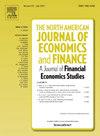Investigating the impact of the Covid-19 pandemic on stock markets volatility in USA and Europe
IF 3.9
3区 经济学
Q1 BUSINESS, FINANCE
North American Journal of Economics and Finance
Pub Date : 2025-09-20
DOI:10.1016/j.najef.2025.102540
引用次数: 0
Abstract
Financial data exhibit distinctive characteristics known as stylized facts including volatility clustering, long memory, the leverage effect, and risk premium.
In this paper, we introduce a innovative volatility model (ARFIMA-HYAPGARCH-M) designed to effectively capture these features in both the S&P 500 and the European STOXX600 indices, before and during the Covid-19 pandemic.
Empirical findings reveal a significant surge in return volatility across both U.S. and European stock markets during the pandemic. Moreover, the data exhibit dual long memory properties in both the mean and variance of returns, along with an evidence of asymmetry and the leverage effect. Furthermore, the results show that risk premiums increased during the Covid period, confirming that investors demand higher compensation during periods of “bad” volatility compared to periods of “good” volatility.
As such, the ARFIMA-HYAPGARCH-M volatility model provides a valuable tool for improved risk assessment, enabling investors and portfolio managers to make more informed decisions. Additionally, the model can enhance the performance of hedging strategies by accurately capturing volatility dynamics.
调查新冠肺炎疫情对美国和欧洲股市波动的影响
金融数据表现出被称为程式化事实的独特特征,包括波动性聚类、长记忆、杠杆效应和风险溢价。在本文中,我们引入了一个创新的波动率模型(ARFIMA-HYAPGARCH-M),旨在有效地捕捉标普500指数和欧洲STOXX600指数在Covid-19大流行之前和期间的这些特征。实证研究结果显示,在疫情期间,美国和欧洲股市的回报率波动性大幅上升。此外,数据在收益的均值和方差中都表现出双重长记忆特性,同时也有不对称和杠杆效应的证据。此外,结果显示,风险溢价在新冠肺炎期间有所增加,这证实了投资者在“糟糕”波动期间比“良好”波动期间要求更高的补偿。因此,ARFIMA-HYAPGARCH-M波动率模型为改进风险评估提供了一个有价值的工具,使投资者和投资组合经理能够做出更明智的决策。此外,该模型可以通过准确捕捉波动动态来提高对冲策略的性能。
本文章由计算机程序翻译,如有差异,请以英文原文为准。
求助全文
约1分钟内获得全文
求助全文
来源期刊
CiteScore
7.30
自引率
8.30%
发文量
168
期刊介绍:
The focus of the North-American Journal of Economics and Finance is on the economics of integration of goods, services, financial markets, at both regional and global levels with the role of economic policy in that process playing an important role. Both theoretical and empirical papers are welcome. Empirical and policy-related papers that rely on data and the experiences of countries outside North America are also welcome. Papers should offer concrete lessons about the ongoing process of globalization, or policy implications about how governments, domestic or international institutions, can improve the coordination of their activities. Empirical analysis should be capable of replication. Authors of accepted papers will be encouraged to supply data and computer programs.

 求助内容:
求助内容: 应助结果提醒方式:
应助结果提醒方式:


